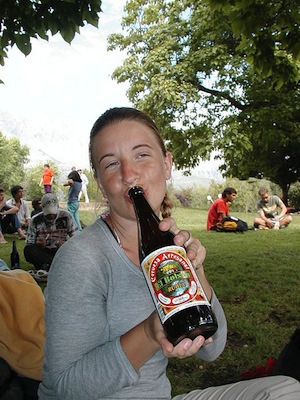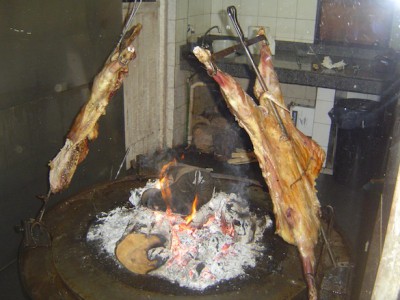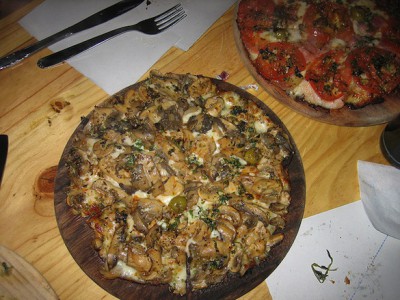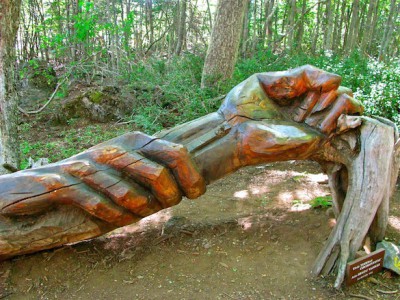EL BOLSON, ARGENTINA. When it comes to ordering beer in the Argentine Patagonia, foreigners may well need a dictionary. At the Otto Tipp brewery in El Bolsón, a Pilsner is called gringa (gringo being the colloquial Latin American express for “American”), while a stout is referred to as mulata. An even more basic term that applies to almost all beers sold in El Bolsón, however, is cerveza artesanal, meaning artisanal or craft beer.
With its cocky, colloquial names for many of its beers, the Otto Tipp brewery is the oldest Patagonian craft brewery in El Bolsón (Av. Islas Malvinas and Roca, Tel. 02944 49-3700). It carries the name of its founder, Otto Tipp, one of the many German immigrants who settled here in 1890. In fact, rumor has it that Tipp was the region’s beer pioneer who showed other inhabitants how to grow hops.
Golden bordering on amber, Tipp’s gringa is crowned with white, long-lasting foam when you pour it. Cloudy in color, the gringa has a fruity taste rich in malt and with citric as well as herbal touches. A slight aroma of honey, as well as the more typical taste of yeast, can also be discerned. Not too little, not too much carbonation make it pleasant to savor. Above all, it’s a beer where the taste of grain dominates; slightly acidic but nevertheless refreshing. The perfect combination of sweet and bitter make the gringa an ideal way to end a day of hiking in El Bolsón.
If you prefer a dark beer, try the mulata. To the eyes, the mulata is opaque, but to the taste buds, it is incredibly refreshing. In contrast to the gringa, the mulata comes with less foam and a pleasant consistency. Toasted malt resonates in the background of your palate; the bitter aroma is similarly kept quiet. Every sip you take appears more refreshing than the one before. Why? If you’re tongue hasn’t discerned it yet, just turn the bottle around; mint is one of the key ingredients. Tipp really knows how to innovate.
The success of Tipp’s creations quickly proved that the area was more than suited to craft brewing. Just 120 km south of the popular ski resort Bariloche, El Bolsón is similarly replete with rugged, often snow-capped mountain peaks. Further down, these mountains turn into valleys, alive with soaring trees, lush bushes, and in spring, blooming flowers and budding berries. Add to that the water provided by the Río Azul (literally meaning “blue river”), and you have a fertile environment ideally suited for growing hops and more.
In addition to the fertile landscape, there was, and still is, a human factor that plays a role in the popularity of craft brewing in El Bolsón. Unlike its elegant, chic counterpart Bariloche, El Bolsón is a hippie town flourishing with alternative arts and culture. The town’s feria regional (regional fair) dates all the way back to the 1970s, when hippies began settling here. To this day, the very same hippies and their children come together in the main square on Saturdays to sell arts and crafts, including hand-made T-shirts, artisanal leather goods, traditional instruments and more. It is no surprise that within this laid-back lifestyle focusing on artistic creation, craft beer would also remain popular.
Both tourists and locals can indulge in a unique experience of the region’s brews. If you’re in town in February, be sure to check out the annual hops festival. You can also start way back in time with a tour of the Otto Tipp factory, where you will learn about the history of the brewing process from 1890 to the present day. Your mouth will water as you see the artisanal beer being brewed first-hand. And to reward your palate, you can taste samples at the end. Should that tiny sample leave you wanting more, sit down for a full-size drink and a filling meal at the Otto Tipp restaurant. To accompany your gringa or mulata, you can choose anything from a typical Argentine steak, a grilled fish or a homemade empanada. The waiter will be happy to recommend which food is best suited to accompany the beer you have chosen. Those who want to head directly to the meal, can skip the tour and do so of course, too.

Cerveza Artesanal | guspatagonico.
While the Otto Tipp brewery is steeped in history and tradition, the more adventurous should head to the Cervecería El Bolsón (Ruta 258, Km. 123,9. Tel. 02944-492595). It came into business more than one hundred year later than Otto Tipp, but has certainly made a name for itself since its inception in 1987. Now, you may wonder why its creations are described as adventurous.
Before we get to that, however, the Cervecería El Bolsón has the traditional brews. The rubia tradicional, literally meaning traditional blonde, comes in that precise blonde hue. Inspired by the traditional Pilsner brews, this beer is fermented at low temperatures and achieves a very special equilibrium of aromas, body and taste. Hazy with a medium sized white head, the rubia tradicional has a malty, yeasty aroma. Highly carbonated, it also comes with reminiscences of grapefruit and lemon. Perfect for a high-carb meal such as pizza.

Cordero Asado | Albasmalko.
The negra extra is similarly recommended to accompany sandwiches, pastas as well as cooked meats. Negra extra means extra black (equivalent to extra stout), and the dark color comes from the toasting of the malt, which is grained to achieve the beer’s particular body and sweetness. When poured, the beer comes in that very dark brown color while a fizzy head adorns it with a caramel color. Rather fast, a thin rim is what remains. The carbonation, however, prickles on, as do tastes of prunes, figs, molasses, chocolate and bitter coffee. Particularly the fruit aromas remain in the aftertaste.
In fact, El Bolsón is a region rich in raspberry, cassis, and cherries, and Cervecería El Bolson sells a beer version of all of them. Those who have a sweet tooth should go straight to one of the berry or fruit-flavored versions. Celiacs, too, can finally enjoy a beer here; the establishment has a gluten-free rubia, negra and rasberry-flavored versions available.
If you like it sweet, you’ll be enthralled, both in aroma and in taste, by the cerveza con miel (beer with honey). This creation comes in that very honey color and once opened, is embellished by a decent foamy head. The honey, which might be too overpowering for some people, tastes like real honey. And that’s precisely what it is; prepared exquisitely thanks to El Bolson’s autumn harvest. “Revitalizing” is what the owners themselves term this creation.
Now to the particularly adventurous: it is at Cervecería El Bolson that you should give your taste buds a challenge and try a cerveza picante. Golden in color, this beer undergoes a special maturation process to give it its spicy taste, flavored with ají (chili). The smell already announces the presence of the ají, which combines the tenuous sweet aromas. No need to be afraid; it’s actually not that spicy on the tongue and intensifies only at the end, as if leaving a distant memory of a spicy visitor. Each bottle contains a tiny piece of ají. Ideal for accompanying Mexican or criollan, spicy dishes.

Homemade Pizza | Petezin.
Regardless of how extroverted you might be in your beer preference, check out cervezaselbolson.com to virtually explore all the different tastes before you go. While you are at it, you can also find out which beer best fits with which food. This way, once you get to Cervecería El Bolsón’s restaurant, you will know whether to order carne roja (red meat) or one of the homemade pizzas.
Once you have recovered from the adventure at Cervecería El Bolsón, you can keep exploring. El Bolsón is home to more than 25 craft beer brands, the most famous being Araucana, Cerveza Piltri, Parapapoto, Tres Puentes, Kelly, Vikinga, Ilegales, Rupestra, Cavall de Foc, and Pilker. Since not all of them have official tasting facilities, scout around the local supermarkets to pick up a pint. If you’re in the mood for a true mountain creation, try Cerveza Piltri, which derives its name from Cerro Piltriquitrón, El Bolsón’s highest mountain with an altitude of 2260 meters.
In fact, you could make a point of climbing Cerro Piltriquitrón first, and then rewarding yourself with a beer. (The other way around is probably not such a good idea). You can either walk or drive up the windy road leading from the Villa de Turismo to the plataforma. From here, it takes about 45 minutes to the Refugio Piltriquitrón (Piltriquitrón mountain hut, 1450 m. above sea level). Highly recommended is a stop at the Bosque Tallado, a collection of wood sculptures created when the surrounding forest burned down in 1978.
Depending on when you arrive at Refugio Piltriquitrón, you have various options: to trek to the top, – the cumbre, – or to stay overnight and leave it for the next day. (Or not to go to the cumbre at all, but that would be a great pity). Trekking to the top will take anywhere between 1.5 and 3 hours, depending on weather conditions and personal fitness. The path starts with a relatively easy upward hike, but the last part involves some gravel, so be sure to wear sturdy shoes. At the top, you’ll be rewarded with a spectacular 360-degree view of the town below. Let the wind blow in your face and feel like you are on top of the world. And once you’ve made it back down to the Refugio, order some homemade pizza, a local beer and toast to El Bolsón!
Planning your trip to El Bolsón
Getting there
- By bus: there are frequent connection to Bariloche, Buenos Aires, Mendoza and El Calafate. Check out www.plataforma10.com.ar for tickets.
- By car: rental cars are available in El Bolsón, but they will probably be less expensive in Bariloche. Take the RN 40 south from Bariloche.
- By plane: national flights arrive in Bariloche. You can then head south by bus or car.
Where to stay
El Bolsón offers accommodation from comfortable hotels to hostels to beautiful campgrounds. If you’re seeking accommodation off-the-beaten track, consider La Casa del Viajero, an affordable hostel with shared and private rooms. The owner, Agustín Porro, is the one who started El Bolsón’s arts and crafts fair back in 1979. He is still a hippie at heart and even provides free bikes for the ten-minute ride into town. If you’re up for pitching a tent, check out Camping Río Azul, where you can set up your new home right next to the “blue river.”
Further information can be found at Bolsón Web.
When to go
High season in El Bolsón is from December to February, with another rush of crowds in mid-June to mid-August (summer holidays in Argentina). Prices drop during the months in between, yet weather conditions can involve cold, rain and snow. The hops festival is held in February.







